NOTE: For prior parts in the Hizballah Cavalcade series you can view an archive of it all here.
—
The Shia Militant Response to Ayatollah Nimr al-Nimr’s Death Sentence
By Phillip Smyth
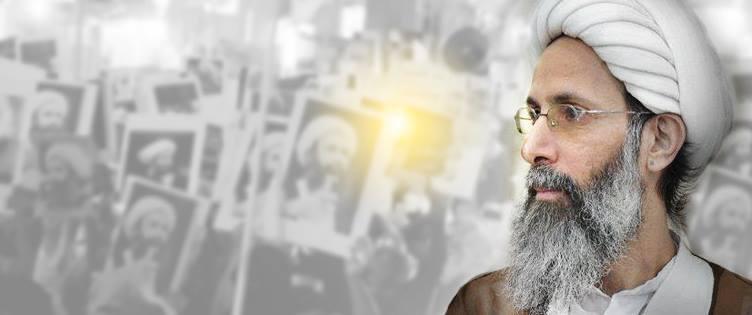
Ayatollah Sheikh Nimr Baqr al-Nimr, an outspoken radical Saudi Arabian Shia cleric, has been the center of controversy and brewing conflict between Shia protesters, militant Shia groups of Saudi Arabia and Bahrain, and their respective Sunni governments. According to a 2012 article by Toby Matthiesen, al-Nimr was, “long a peripheral figure in the local Shia power struggle but now seems to have become the most popular Saudi Shia cleric among local youth.”1 His cause and image is spreading across the Middle East as the latest example of Sunni oppression of Shia in the region and his recent death sentence has become a potent rallying cry for regional Shia militant organizations, particularly those with links to Iran.
Arrested in 2012, Nimr was accused by the Saudi government’s Special Criminal Court of making sectarian statements to cause strife, inviting foreign intervention (shorthand for Iranian influence), and disobeying the king. Following his 2012 arrest, thousands took to the streets and Saudi police shot and killed two protesters.2 In mid-October 2014, Nimr was sentenced to be “crucified”, a process where the sheikh will be beheaded and his body displayed.3
Protests in Saudi began in early 2011 and in part addressed anti-Shia discrimination suffered by the group in the Shia majority area in Saudi Arabia’s oil-rich Eastern Province; primarily zones around the Shia-majority towns and villages near the city of Qatif.4 Following the 2011 Saudi intervention in Bahrain, protests against the Saudi government increased in Bahrain and Saudi Arabia among Shia protesters.5 Following the 2011-2012 protests, links between Bahrain’s and Saudi Arabia’s protest movement spilled over into the more militant circles which actively promoted Nimr’s defiant stance and a hope to combine their fronts against common foes.
Of further interest are Nimr’s own ideological leanings and how they may relate to Shia militant responses. In Frederic Wehrey’s Sectarian Politics in the Gulf, the sheikh is described as a follower of the late Ayatollah Muhammad al-Shirazi.6 Shirazi was one of the founders of a radical Shia political school of thought referred to as the “Shiraziyya.” Shiraziyya clerics have been some of the most influential in the Arab Shia world. Initially al-Shirazi agreed with the Islamic revolutionary ideology of Ayatollah Khomeini, only to split from Khomeini over issues regarding how the new Islamic state (in Iran post 1979 revolution) should be led.7 In one BBC Arabic report, Nimr had been accused by Riyadh of attempting to spread Wilayat al-Faqih.8 Absolute Wilayat al-Faqih is the Khomeinist concept that serves as the basis for the Islamic Republic of Iran. Nevertheless, it was not clarified whether this was the type of Wilayat al-Faqih Nimr was accused of propagating.
Despite the history of strife between Shirazi’s school of thought and that of Ayatollahs Khomeini and Khamenei, al-Nimr appeared to increase public support for Tehran and send other more mixed messages. In 2008, he had also reportedly stated he supported Iran’s nuclear program by saying any attack against it should be met by a response from the Islamic world. That same year, he also said that Saudi Shia may need to call on foreign support (implying Iran) to help press their issues in Saudi Arabia.9 Later in 2009, Nimr reportedly called for secession, stating during a sermon, “Our dignity is more precious than the unity of this land.”10 His statement came as a response to discrimination against Shia in the kingdom and reflected possible repercussions if certain demands made by Shia protesters were not addressed.
Since 2013, in a piecemeal fashion, social media accounts associated with Iranian proxy groups in Iraq have promoted the images and other supportive statements for Ayatollah Nimr al-Nimr.11 While this does not necessitate that Nimr is a true ally or proxy of Tehran, his message and influence is likely seen by Iran as a cause to be promoted in that country’s wider struggle for the leadership of Shia Islam and as a counter to Saudi Arabia.
Nimr’s deep links and strong voice within the Saudi Shia community, particularly among youthful radicals and other more non-violent protestors, has led to Shia militant groups championing his cause from Bahrain and Iraq. Even in Yemen, Shia supporters of Ansar Allah, more commonly known as the Houthis, even launched demonstrations for the jailed cleric.12 Some Bahraini militant groups, which view the struggle of their coreligionists in a geographically close region of Saudi Arabia, as part and parcel to their conflict with the Khalifa monarchy and their Saudi government supporters. Additionally, powerful Iranian proxy groups based in Iraq—which have also maintained anti-Saudi and anti-Bahraini government narratives—have taken to issuing stern threats against Riyadh for his sentence.
The Violent Replies From Saudi Arabia’s and Bahrain’s Militants
Bahraini militant groups demonstrated the most concerted effort in terms of orchestrating violent retorts to Nimr’s jailing and sentence. While other threats and attacks were conducted since the start of 2014, this piece will focus on more recent threats and attacks beginning in the summer of 2014.
Bahrain’s Saraya al-Mukhtar (SaM), a group which once said the Saudi Shia of the Qatif and the Shia of Bahrain constituted one people with common foes, launched the most attacks over the longest period specifically addressing Ayatollah Nimr al-Nimr’s arrest, trial, and death sentence.
Starting in August, SaM attacked an electricity tower in Ar-Rifā near a Bahraini military base. The group filmed the attack and stated it had been a warning related to the imprisonment and trial of Ayatollah Nimr al-Nimr. Around the same time, SaM also began an online countdown for the Nimr verdict and increased their threats against Saudi Arabia. The group also ratcheted up it’s pro-Nimr messaging with the release of numerous images.
This messaging coincided with Saraya al-Mukhtar making its first direct threat against U.S. military personnel in Bahrain on August 11. Through an image posted to Facebook, SaM stated that, “The American cover on al-Saud and Al_Khalifa crimes,,Marines in bahrain will pay the price. [sic]” The message essentially claimed that the U.S. was the real backer for the Khalifa and Saud monarchies. As a result, they bore equal responsibility and could be targeted.
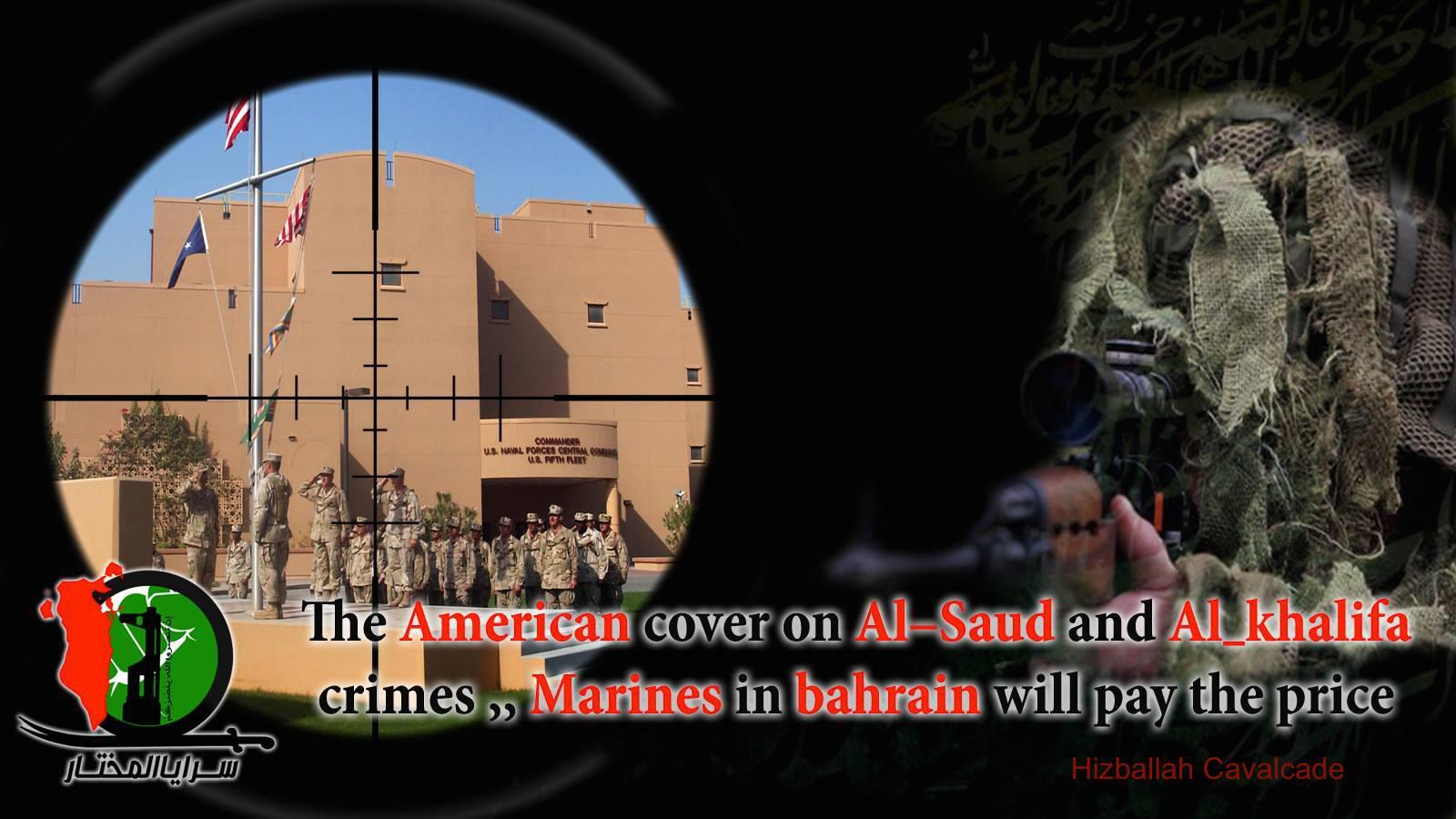
Figure 1: Saraya al-Mukhtar’s anti-American message posted on August 11, 2014.
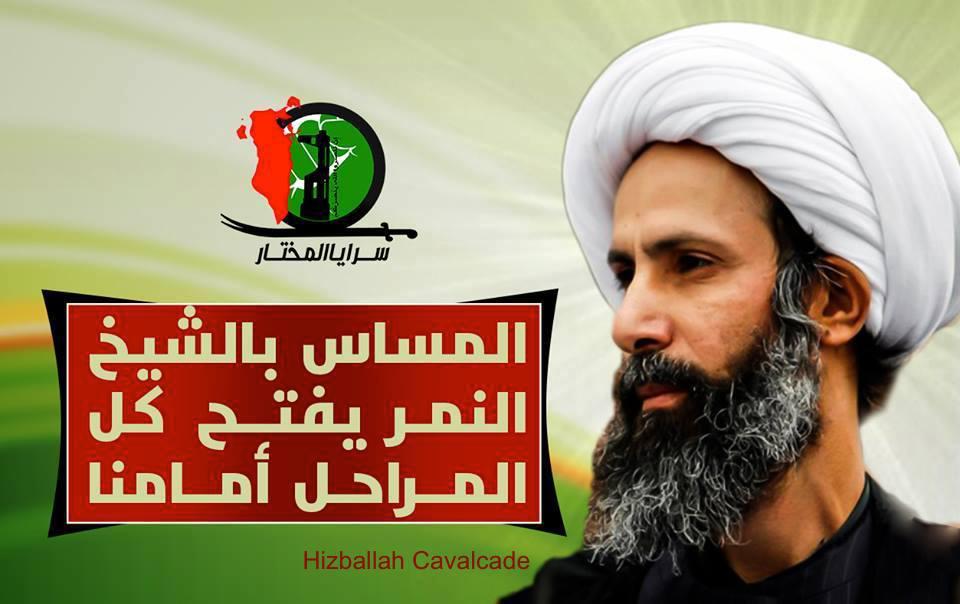
Figure 2: A Saraya al-Mukhtar photo for Ayatollah Nimr al-Nimr posted on August 8, 2014. The poster reads: “Sheikh Nimr[‘s trial and poor treatment] will make us put all options on the table.”
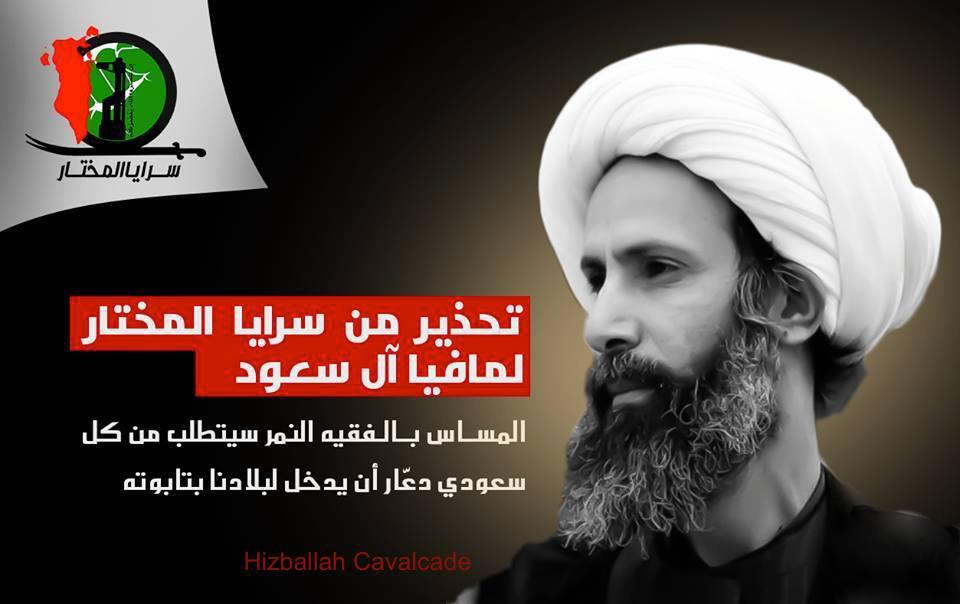
Figure 3: A Saraya al-Mukhtar photo posted on August 10, 2014. This poster reads: [in the red box] “A warning from Saraya al-Mukhtar to the mafia of the Sauds [in white text] Harming Sheikh Nimr will make us put all options [on the table]. Harming the Faqih Nimr means every single Saudi national will enter our country in a coffin.”
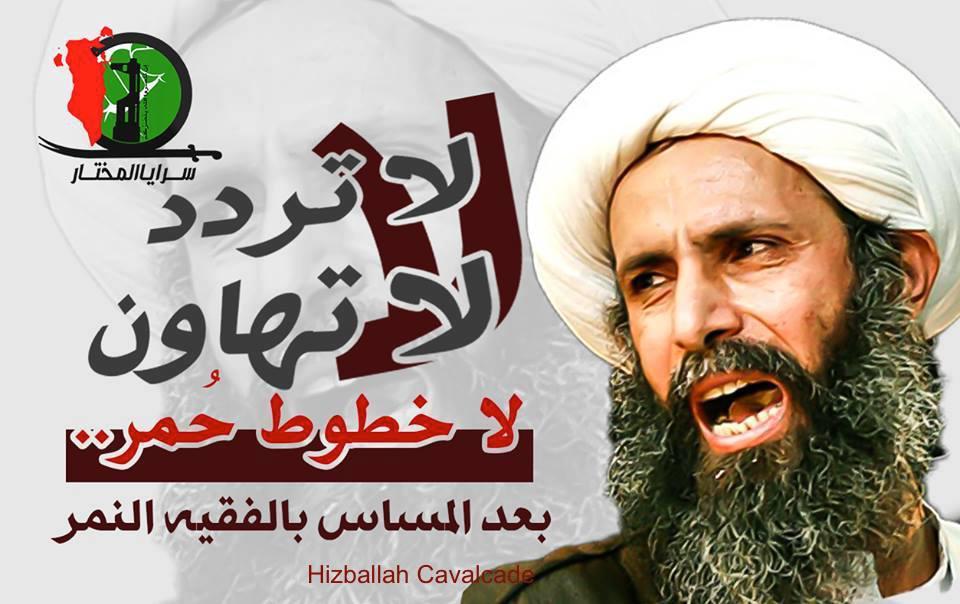
Figure 4: A Saraya al-Mukhtar photo for Ayatollah Nimr al-Nimr posted on August 11, 2014. The poster reads: “Do not hesitate, Do not underestimate, No red lines.. after [the] discrimination [against] the Faqih al-Nimr.”
On September 16, SaM announced it had planted 6 explosive devices in retaliation for al-Nimr’s incarceration. Albeit, these bombs did not target U.S. interests and there was little confirmation as to whether any devices were actually planted.

Figure 5: Saraya al-Mukhtar’s September 16 claim to have planted 6 bombs.
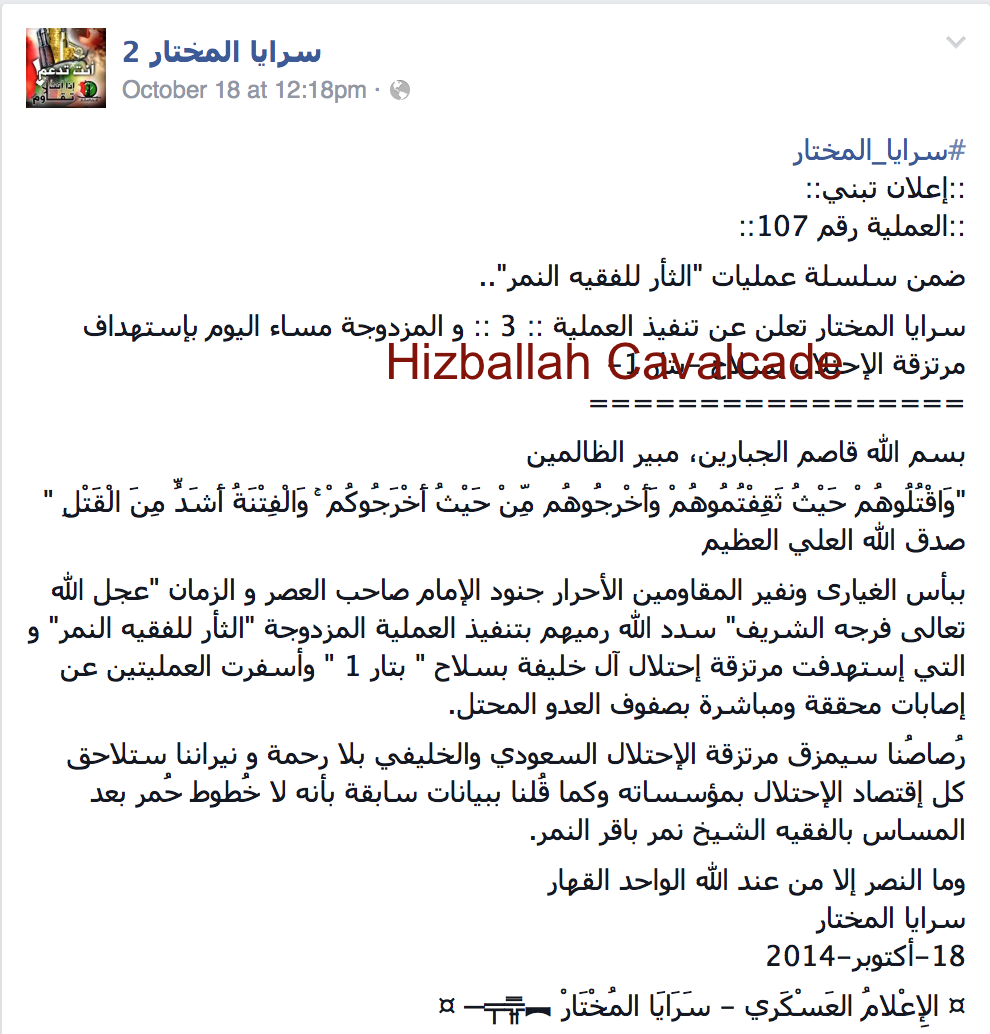
Figure 6: Saraya al-Mukhtar’s claim of 2 attacks on October 18, 2014.
Then on October 9, SaM claimed to conduct an attack in the town of Karana, Bahrain utilizing an improvised firearm. SaM’s claim of responsibility stated they attacked, “herds of mercenaries” (shorthand for Bahraini police and other security entities). On October 15, SaM claimed to have launched attacks in Sanabis and Aker, Bahrain targeting “mercenaries”. In another statement from that day, the group threatened, “The occupying mafia of al-Saud and al-Khalifa [would face]…consequences for the death sentence.” Later, on October 18, SaM claimed two attacks, referring to them as “Revenge of the Faqih [an expert in Islamic jurisprudence] Nimr.” SaM’s statement declared that it had injured “ranks of the enemy occupier.”

Figure 7: SMS’s claim of attack in honor of Sheikh Nimr.
Bahraini militant group, Saraya
Category: Saraya al-Muqawama al-Sha’biya
Hizballah Cavalcade: Singing Hizballah’s Tune in Manama: Why Are Bahrain’s Militants Using the Music of Iran’s Proxies?
NOTE: For prior parts in the Hizballah Cavalcade series you can view an archive of it all here.
–
Singing Hizballah’s Tune in Manama: Why Are Bahrain’s Militants Using the Music of Iran’s Proxies?
By Phillip Smyth
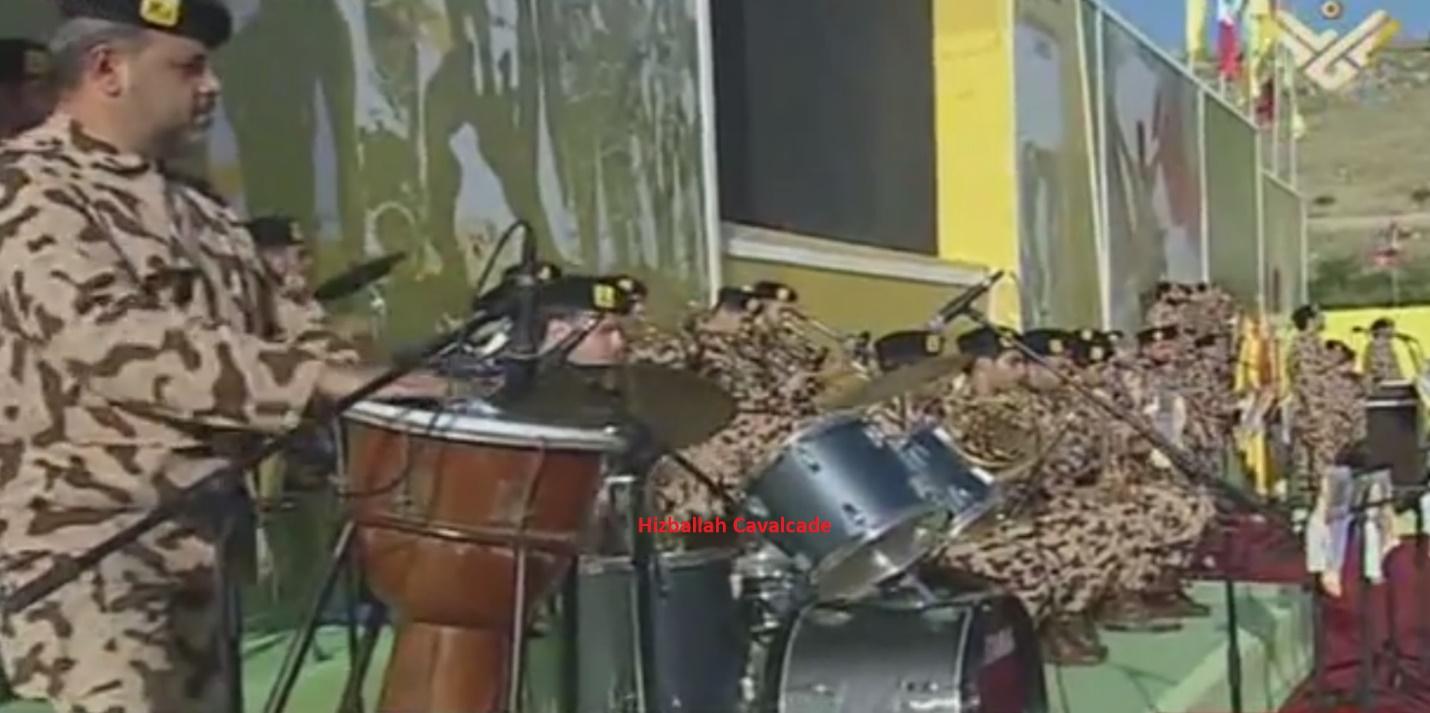
Figure 1: A screenshot of a Hizballah musical band performing at the 2013 “Resistance and Liberation Festival”
Bahraini officials have repeatedly accused anti-government militants and protesters in the country of being supplied, trained, and supported by Iran and its numerous regional proxies. Still, the government of Bahrain has done little to bolster their claims of deep and intrinsic links between Bahraini militants and Tehran. Along with official Iranian denials, the issue of Iran-Bahraini militant links is still quite hazy. Nonetheless, this does not mean that within the material released by Bahraini militant organizations that there are not hints of some level of Iranian influence. One of the more intriguing pieces pointing to influence from Iranian-backed organizations comes from the utilization of specific types of music in the many propaganda videos released by Bahraini militants, their sympathizers, and amplifiers.
Numerous instances of Bahraini militants producing propaganda videos with different varieties of music created and utilized by Iranian-backed proxies could indicate a connection with Iran’s proxies. Nevertheless, this type of overlap should not be viewed as a “smoking gun” affirming Iranian involvement. However, it does assist in piecing together direct and indirect influences.
The pieces of music in question were originally developed and used by Iranian proxy organizations, particularly Lebanese Hizballah, Asa’ib Ahl al-Haq (AAH), and Kata’ib Hizballah. In fact, some of the songs that have been promoted fit a long standing media strategy employed by the aforementioned groups and Iran when manufacturing narratives and perceptions for themselves and other armed groups.
The use of music as a transferable propaganda medium follows a very formulaic strategy used by Iran and its “Islamic Resistance” proxy organizations for many years. Often, songs produced for one group are repackaged for newer organizations in other geographic locations. The songs are then altered in a way to make them appeal to the populations and target audience where the new group is located.
Possible Reasons for Using Specific Songs
Why would Bahraini militant groups utilize Hizballah and its Iraqi clones’ music and with such frequency? Some possible answers include:
- Direct Iranian influence or assistance provided to the developing militant groups.
- Video editing/production was offered to Bahraini militants by Iran and/or its proxies as a means to influence and shape militant organizations and to encourage the adoption of a more bellicose strategy to the broader (and more peaceful) protester audience.
- Bahraini militants sympathize with Iranian-proxy groups, their exploits, and with the general concept of “Al-Muqawama al-Islamiyya” (“The Islamic Resistance”). The hope to be as successful, feared, and/or respected as those organizations has led them to adopt the same varieties of music.
- Thumbing their nose at the government: With the government of Bahrain accusing protesters and militants of being Iranian proxies, militant groups may use the material as a way to subtly frighten or encourage speculation among Bahraini government and other observers.
- Narrative Goals: One song by Lebanese Hizballah’s Ali al-Attar called “Wa’ad al-Asra” or “The Prisoner’s Promise” was written to celebrate the release of prisoners Hizballah sought to free during the 2006 Hizballah-Israel War. While the song makes clear references to Lebanese Hizballah and themes related to the 2006 war, the same song was employed by some Bahraini protesters (as background music for their uploaded clips) when they protested the government’s detention of key protest-leaders.
Auto-Tuning the Revolution: Examples of the Musical Overlap
In March 2014, a music video which was claimed to have been produced by “Saraya al-Bahrainiyya al-Muqawama” or the Bahraini Resistance Brigades, (which is likely another name used by The February 14 Youth Coalition’s Saraya al-Muqawama al-Sha’biya [Popular Resistance Brigades]) was posted by the popular Revolution Bahrain’s YouTube Channel. The video featured a montage of edited clips, which purported to show Bahraini militants engaged in training. The music video also included a number of videos of bombings orchestrated by militant Bahraini organizations.
Yet, the music used was strikingly familiar in the circles of Iranian-backed Shi’a Islamist groups. In fact, Iranian-backed Iraqi group, Asa’ib Ahl al-Haq had released the exact tune back in 2011 to commemorate attacks the group orchestrated against U.S. targets to demonstrate solidarity with Bahrain’s protesters. Later in 2011, when fellow Iranian proxy Kata’ib Hizballah released footage of attacks it had also launched in solidarity with Bahraini protesters, it too used the same song.
However, the song was neither originally Bahraini nor Iraqi, instead its origins were rooted father to the west, in Lebanon. The original song, “Risalat al-Thuwar” (“Message of the Rebels”), was performed by one of Lebanese Hizballah’s official bands, Firqat al-Fajr (The Dawn Band), following the 2006 Hizballah-Israel War. It first appeared on the band’s 2007 “Lahan al-Turab” or “Melody of the Soil” album. Still, the rendition dealing with Bahrain was not the only version of the song. Asa’ib Ahl al-Haq had their own Iraq/Grand Ayatollah Muhammad Muhammad Sadiq Sadr (as opposed to Sayyid Hassan Nasrallah) themed “Risalat Thuwar” produced in 2011.
“Risalat al-Thuwar” is not the only Hizballah song which has been adopted and rebranded by Bahraini militants and their amplifiers. Another song used by Bahraini militants also comes from Firqat al-Fajr. The song, “Ya Wa’ad Allah” (“O Promise of God”) can be found on the group’s 2008 album, “Sharit Wa’ad Allah” (“Take the Promise of God”). The song has been released in different formats, with more recent music video varieties showcasing the assassinated Hizballah terror-mastermind Imad Mughniyeh. The album also included an instrumental version of the song. Both versions have been prominent features on productions done by Hizballah’s Al-Manar TV network.
In Bahrain, “Ya Wa’ad Allah” was used as background for clips released to the popular (particularly with militant groups) Revolution Bahrain’s YouTube account. One of these videos included the firebombing of an armored car used by Bahraini government forces.
It is not just the polished music video-quality material finding its way into Bahraini militant propaganda productions. Bahraini militant group Saraya al-Mukhtar released a video of their April 2014 targeting of Bahraini police with an improvised explosive device. Another bomb attack in Bani Jamra also utilized the same background music.
The musical selection in the background matched with instrumentals used by Iraq’s Asa’ib Ahl al-Haq. This music was first featured on the AAH-affiliated Al-Ahad TV in the late summer/fall of 2013 to commemorate Asa’ib Ahl al-Haq members killed fighting in Syria. Further pointing to some level of Iranian or Iranian proxy influence, is highly unlikely that this particular musical element could find its way into so many pieces of released footage. This may indicate some Bahraini militant footage being sent abroad (possibly to Iraq) where the footage is re-edited and put back together for a later introduction.
Another similar instrumental used by Bahraini militants with Saraya al-Mukhtar and Saraya al-Ashtar was also the same exact tune utilized in a number of Kata’ib Hizballah video releases (see: 00.17-00.40 on “Kata’ib Hizballah Anti-America Video”).
The use of the last two instrumentals create further questions. Why would these groups, which have resorted to using a variety of improvised weapons, and exist under increasing heavy security crackdowns, spend the time to find, edit, and utilize background instrumentals which already have obscure points of origin. Why pick these two exact instrumentals, which have only been found in the repertoire of Asa’ib Ahl al-Haq and Kata’ib Hizballah? Other Bahraini protest organizations have utilized a variety of different musical accompaniments. Thus, the use of these particular musical pieces seem out of place when compared to the rest of what has been released.
Whatever the reasons, closely assessing the propaganda published by these organizations may provide insight into rather opaque organizations. While assessing the musical selections may appear to be a tangential escapade, AAH, Kata’ib Hizballah, and Lebanese Hizballah have all demonstrated their strategy of using this material as another method to push the narrative of the “Islamic Resistance.”
Hizballah Cavalcade: Bahrain’s Saraya al-Muqawama al-Sha’biya: Militants of the February 14 Youth Coalition
NOTE: For prior parts in the Hizballah Cavalcade series you can view an archive of it all here.
—
Bahrain’s Saraya al-Muqawama al-Sha’biya: Militants of the February 14 Youth Coalition
By Phillip Smyth

Figure 1: Saraya al-Muqawama al-Sha’biya’s logo.
Saraya al-Muqawama al-Sha’biya (The Popular Resistance Brigades or SMS), sometimes also called Saraya al-Muqawama (The Resistance Brigades), was listed by the government of Bahrain as a terrorist organization following the deadly March 3, 2014 bombing. The group, along with fellow militant group Saraya al-Ashtar, claimed responsibility for the attack. SMS has been operationally active and publishing its activities online since April 2012. Importantly, Saraya al-Muqawama al-Sha’biya does not hide that they are affiliated with one of the main anti-government protest groups, the February 14 Youth Coalition (which was also listed as a terrorist organization by the government of Bahrain). This is hardly a minor connection, since, both the February 14 Youth Coalition and SMS have also distributed images sharing one another’s logos, organized events (such as protests) together, and share a similar narrative. Other militant groups—namely Saraya al-Ashtar and Saraya al-Mukhtar—have only vaguely claimed to represent links to protestors, let alone main protest organizations.
In June 2013, the Bahraini government accused the February 14 Youth Coalition of having a “spiritual leader” based in Karbala, Iraq and of, “frequently travel[ing] between Iran, Iraq and Lebanon to obtain financial and moral support as well as weapons training.” However, Bahraini authorities provided little substantiating evidence dealing with claims of Iranian or Iranian proxy involvement. Nevertheless, according to Iranian reports, February 14 Youth Coalition representatives have thanked Iranian Supreme Leader Ayatollah Ali Khamenei for his comments supportive of their activities. Iranian media has also expressed their support for the “revolutionary activities” of the Bahraini group. Despite these pronouncements, the actual relationship between Iran and the February 14 Youth Coalition, particularly dealing with any attempts at training or equipping militant elements attached to the organization, is still unknown.

Figure 2: Both the February 14 Youth Coalition and Saraya al-Muqawama al-Sha’biya’s logos on a promotional image released onto multiple February 14 Youth Coalition pages.

Figure 3: SMS supporters carry the group’s flag during a march.

Figure 4: SMS and February 14 Youth Coalition supporters march together and carry February 14 Youth Coalition flags.
Initially, the February 14 Youth Coalition did not embrace violence. However, after publishing a series of “warnings” to the Bahraini government, Gulf Arab states (namely, Saudi Arabia and the UAE) which have deployed forces to Bahrain, and foreigners recruited into the Bahrain’s internal security forces (often referred to by the group and other Bahraini militants as, “mercenaries”), the coalition issued communiques demonstrating they would choose a more militant path of “resistance.” In a January 27, 2012 English-language statement made by a February 14 Youth Coalition affiliated page, the group issued a statement reading:
“We have so far preserved our right to use force for self-defense, hoping that would make you hesitant from attacking peaceful protestors, women and children. However, common sense and human logic do not seem to work on you…Our people have decided to bring an end to the illegitimate regime…We shall take no responsibility for whatever might happen to the mercenaries after this final warning.”

Three months after this announcement, SMS pushed for a response to the holding of the controversial 2012 Bahrain Grand Prix Formula 1 race. The group released images urging protestors to throw the gas (the group claimed it was poisonous) used by Bahraini police at the race cars. However, no armed action was taken against the race by SMS. It is likely that in such an early stage of development and combined with Bahraini government crackdowns, the group was unable to act.

Figure 5: One of SMS’s English language posters calling for action against the 2012 Grand Prix race.
Narrative Structure
SMS considers its fighters to be “jihadists,” refer to their attacks as “jihadist operations,” and believe they are fighting a “jihad against the infidel Khalifas [Bahrain’s ruling royal family].” While the message of jihad is repeated in many SMS statements, these statements do not share the same level of more complicated religious and ideological messaging found with other non-Bahraini Shia jihadist elements.
SMS also lacks a specific goal for what type of government will rule in Bahrain following a theoretical collapse of the currently ruling Khalifa royal family. Still, this has not stopped the group from constructing complex narratives via militant activity for their enemies.
Following Saraya al-Ashtar’s and SMS’s claim of responsibility for the March 3, 2014 bombing (which killed two Bahraini police officers and a police officer sent by the United Arab Emirates [UAE] to Bahrain), SMS used the opportunity to criticize government claims that forces of the Peninsula Shield Force were being used in conjunction with local Bahraini police forces to counter protests and riots.
Sent to Bahrain in 2011, the Peninsula Shield Force included hundreds from the Saudi military and the UAE’s police force. Officially, these units claimed they were not involved in internal matters in Bahrain and were only interested in securing strategic bases and locations from “external influence.” Regardless, the death of a UAE police officer attached to Bahraini police served as a propaganda coup for SMS.
The timing of the SMS’s bombing claim and messages which proceeded it also fit into a broader message dealing with the Peninsula Shield Force and particularly Saudi Arabia. SMS has demonstrated a specific ire for the Saudis. The organization’s communiques have called Saudi Arabia the “usurper of land,” “occupiers,” and have stated their operations are to “purge the land of its Saudi and Khalifa occupiers.”
In part, this may tie back to February 14 Youth Coalition links to Saudi Shia activists. Researcher Fredric M. Wehrey noted that an “important attribute of the February 14 Youth Coalition is its strong affinity with Shi’a activists in neighboring Saudi Arabia.” Wehrey went on to explain how coordinated protests were conducted by Bahraini and Saudi groups out of solidarity. The February 14 Youth Coalition’s and SMS’s links to the Saudi Shia is also important when viewed in context with announcements by fellow militant organization, Saraya al-Mukhtar. Saraya al-Mukhtar has issued a number of announcements saying they share the cause of the “people of the [Saudi] Eastern Region” –an area heavily populated by Saudi Shia. The shared narrative may demonstrate deeper links between Saraya al-Mukhtar, SMS, and the February 14 Youth Coalition.

Figure 6: A poster released by the February 14 Youth Coalition asking, “Who are the terrorists?” The photo shows Saudi forces crossing the King Fahd Causeway which links Bahrain to Saudi Arabia.
As part of the view casting the Saudis as foreign occupiers, activists from SMS and the February 14 Youth Coalition have drawn parallels between Israel and Saudi Arabia; accusing both counties of using the same techniques of occupation. Prior to a series of March 2014 protests against “Saudi occupation”, the February 14 Youth Coalition and SMS circulated images attempting to link Saudi Arabia and Israel as fellow occupying states. This also extended into the realm of February 14 Youth Coalition partisans attempting to directly link the causes of Palestinian and Bahraini demonstrators.

Figure 7: The Israeli flag flies behind Jerusalem’s Dome of the Rock (left) while a bulldozer is shown destroying the 400 year old Amir Mohammed Braighi Mosque with a Saudi flag behind it (right). The latter incident occurred in 2011 along with the Bahraini government destruction of other Shia mosques. This picture was used as a tool to organize activists for protests and events against the “Saudi occupation.”

Figure 8: A poster showing a Bahraini protester (with February 14 Youth Coalition) and a Palestinian activist. The former looks to the now demolished Pearl Roundabout statue, the latter looks to the Dome of the Rock. The picture attempts to show a unity of purpose and cause between Palestinian and Bahraini demonstrators.
Symbols of the “Popular Resistance”

Figure 9: SMS protesters at a February 14 Youth Coalition event demonstrating against “The Saudi Occupation.”
Shia symbolism is heavily featured in the group’s logo. The most prominent image is the symbolic hand of Shia leader Abbas Ibn Ali; son of the first Shia imam and loyal aid and military leader for the third Shia imam, Husayn ibn Ali. Serving as Husayn’s flag bearer during the historic Battle of Karbala, Abbas’s hand was cut off by one of the forces of Yazid, the reviled leader of the Umayyads, as Abbas went alone to collect water for Husayn’s dehydrated camp. Abbas went on to fight singlehandedly until his other arm was cut off by sword strikes from Yazid’s forces and was then killed. Abbas’s loyalty and steadfastness until being cut down remains an important message for many Shia Muslims.
Another unique feature from the logo is that “The Sacred Defense” is written within the symbolic hand of Abbas. This helps convey that the group’s conflict with the government is viewed as both a defensive and religiously justified action. Intriguingly, the Shia jihad in Syria and the Iran-Iraq War (1980-1988) have (by Shia actors) both been described as “The Sacred Defense.”
Behind the
